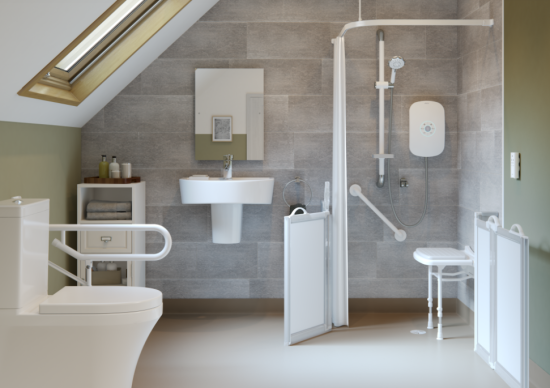
Walk-In Shower or Wet Room? How to Choose the Right Option for Your Home
If you’re thinking about adapting your bathroom for safety, ease of access, or future needs, two popular solutions are walk-in showers and wet rooms. Both are designed with accessibility in mind — but they serve different needs, suit different spaces, and come with their own pros and cons.
Here’s a straightforward guide to help you decide which is right for your home.
Walk-In Showers Vs Wet Rooms - What’s the Difference?
A walk-in shower is a low-threshold shower enclosure. It usually features a glass screen and a shallow tray that makes it easy to step into. It provides a defined space for showering and helps contain water within that area.
A wet room is a fully waterproofed bathroom where the shower is open and integrated into the rest of the room. Instead of a tray, the floor is gently sloped so water drains away smoothly. There’s no step at all, making it completely level with the rest of the room.
Choosing the Right Option
Think About Your Space
If you have a smaller bathroom, a walk-in shower is often easier to fit. It replaces a standard bath or older shower cubicle and makes use of existing space.
A wet room can work well in both small and large bathrooms, but it requires more planning. Since the whole room is waterproofed, you’ll want to make sure the layout prevents water from spreading too far.
Consider Your Mobility Needs
A walk-in shower is ideal if you want a safer, easier alternative to climbing into a bath. The step is very low, and the surface is slip-resistant, making it much more secure.
A wet room offers complete level access, which is especially helpful if you use a wheelchair or have more complex mobility needs. There are no barriers at all — just a smooth, open space that’s easy to move around in.
Look at Maintenance and Cleaning
Walk-in showers tend to keep water within a set area, so there’s less wiping down after each use. They’re simple to clean and contain splashes well.
Wet rooms are designed to handle water throughout the space, but they may need a little more drying off — particularly if the room is smaller. That said, with the right design and drainage, cleaning is still straightforward.
Think About Long-Term Use
Both walk-in showers and wet rooms are great options if you’re planning ahead. They offer safer, more accessible bathing and reduce the risk of slips or trips.
If you’re thinking about long-term flexibility, a wet room can be easier to adapt over time. It’s ideal if you’re planning to future-proof your home, or if you’re supporting someone whose needs may change.
What Style Do You Prefer?
If you like the look of a sleek, enclosed shower space, a walk-in shower delivers that modern feel with clear lines and minimal fuss.
If you prefer a more open, spacious layout, a wet room creates a stylish, contemporary space that feels less confined. It also allows more flexibility in how the room is used.
Still Deciding?
There’s no one-size-fits-all answer. The right choice depends on your space, your mobility, and what makes you feel comfortable and confident in your home.
If you’re unsure, a home survey and design consultation can help you explore both options in detail. That way, you can see how each solution would work in your bathroom before making a decision.






